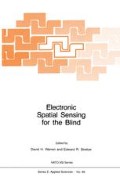Abstract
If given the opportunity to speak openly after trust is gained, many individuals seeking rehabilitative assistance because of vision loss have said words very close to “I’d give anything to be able to see again, even my right arm” or “Without my sight I feel dead” or “If only I could keep what little I have.” Each individual’s perspective upon loss of vision is appropriate for himself and honestly reflects his perception of himself and the impact he feels regarding vision loss. These expressions are consistent with the statements made by so many individuals who, when asked about their purpose in entering into a rehabilitation setting, state simply, directly, and immediately “to see a little better” or “to get glasses that might help me.”
Access this chapter
Tax calculation will be finalised at checkout
Purchases are for personal use only
Preview
Unable to display preview. Download preview PDF.
References
Carroll, T. J. (1961). Blindness: What It Is, What It Does and How To Live With It. Boston: Little, Brown.
Chevigny, H. (1946). My Eyes Have a Cold Nose. New Haven: Yale University Press.
Gorski, R. (1982). To walk and work in comfort. Disabled U.S.A., Fall, 23–27.
Kleck, R. and DeJing, W. (1983). Attitudes toward disabled peers, Rehabilitation Psychology, 28, 32–37.
Koestler, F. A. (1976). The Unseen Minority. New York: David McKay.
Shaw, J. A. S. (1969). Attitudes in blind mobility. The New Beacon, 53, 31–32.
Siller, J. (1983). Rehabilitation Brief, 10, 3–4.
Wright, B. (1959). Rehabilitation Psychology. Washington: American Psychological Association.
Author information
Authors and Affiliations
Editor information
Editors and Affiliations
Rights and permissions
Copyright information
© 1985 Springer Science+Business Media Dordrecht
About this chapter
Cite this chapter
Freedman, S. (1985). Vision Prosthesis and Aids: Readiness or Appropriateness. In: Warren, D.H., Strelow, E.R. (eds) Electronic Spatial Sensing for the Blind. NATO ASI Series, vol 99. Springer, Dordrecht. https://doi.org/10.1007/978-94-017-1400-6_23
Download citation
DOI: https://doi.org/10.1007/978-94-017-1400-6_23
Publisher Name: Springer, Dordrecht
Print ISBN: 978-90-481-8293-0
Online ISBN: 978-94-017-1400-6
eBook Packages: Springer Book Archive

